Our Favorite Adventure Cities
Outdoor pursuits are aplenty in these scenic, recreation-centric towns
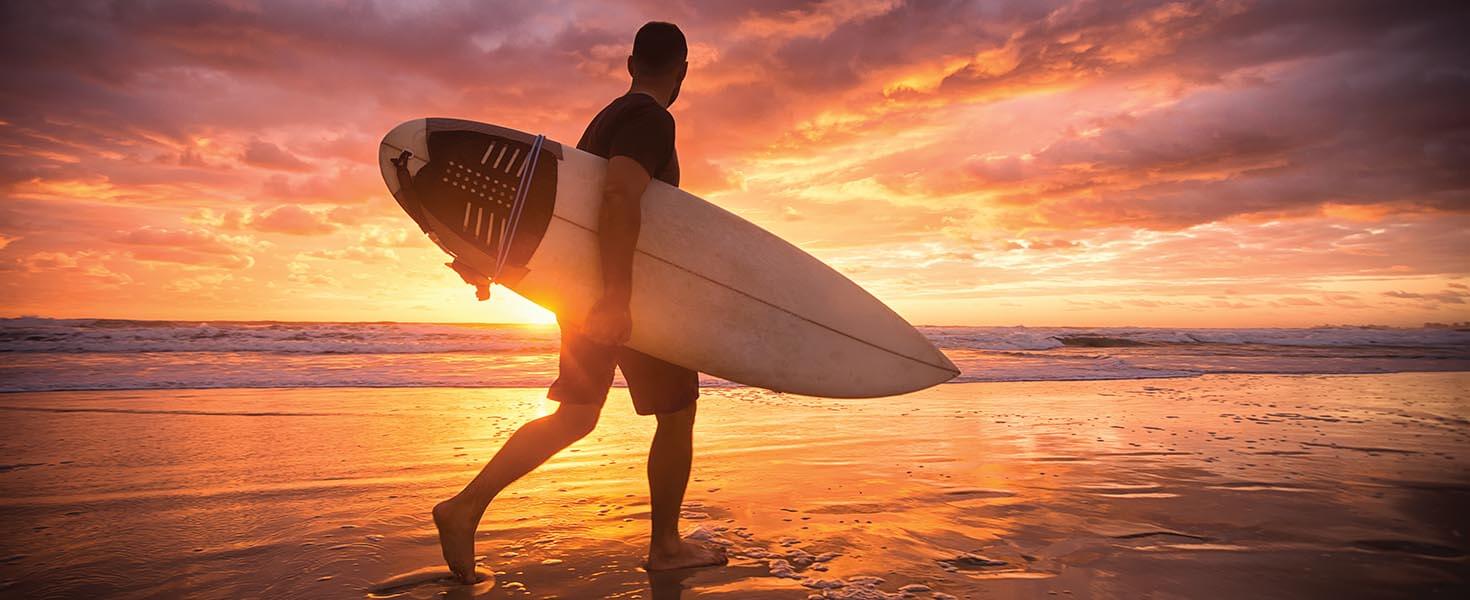

America’s open spaces and off-the-grid landscapes provide ideal canvases for adventure-seeking travelers. But did you know that you needn’t travel farther than your favorite city and its surrounds for exceptional outdoor endeavors? We present some of our most beloved cities that beckon with all manner of alfresco activity—from biking and surfing to paddleboarding, kayaking, and whitewater rafting—spliced with scenes of striking urban beauty.
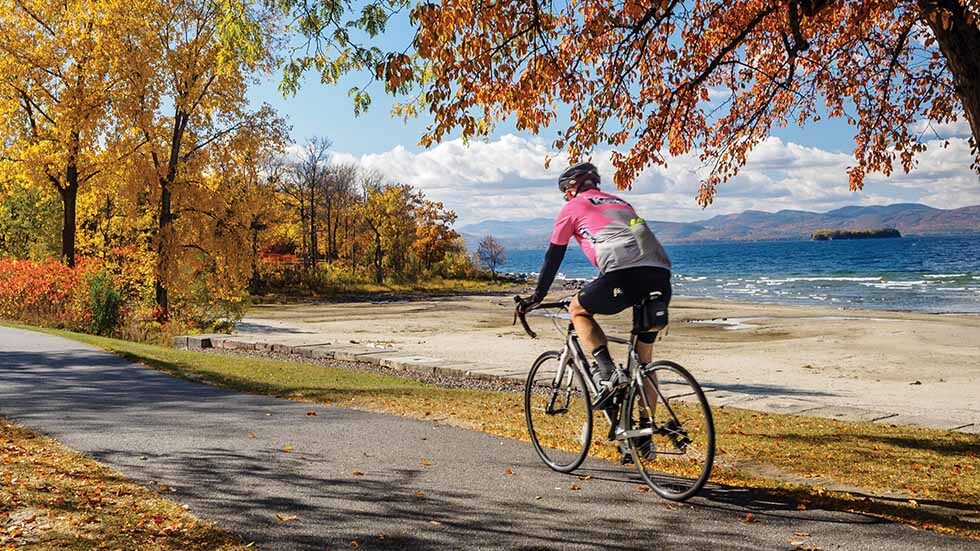
Scenic vistas abound along Vermont’s Island Line Rail Trail, which showcases everything from welcoming public beaches to spectacular foliage to the glimmery waters of Lake Champlain. Courtesy of Local Motion
TAKING THE ULTIMATE BIKE RIDE IN BURLINGTON, VERMONT
The hip, eclectic city of Burlington, the state’s most populous city and home to the University of Vermont, delivers on all metropolitan fronts: the arts, museums, dining, shopping, and more. But to visit this Bicycle Friendly Community, recognized as such by the League of American Bicyclists since 2005, without going on a bike ride would be like, say, going to the beach without taking a stroll along the water. And the most epic bike ride in town is on the Island Line Rail Trail, a restored rail trail that extends nearly 14 miles from downtown, traverses Lake Champlain and culminates in South Hero Island.
If you’ve dreamed of what it would be like to bicycle on water, the experience of biking this strikingly scenic rail trail comes close. What the Florida Keys’ Overseas Highway is to a road trip, the Island Line Rail Trail is to a bike ride.
In 1899, the Rutland–Canadian Railroad laid tracks here to connect the New England coast with the Great Lakes region, carrying passengers and freight for the following 60 or so years. Nowadays, transportation comes in the form of bike rentals (both traditional and e-bikes) from nonprofit bicycle advocacy group Local Motion, with a rental location smack-dab on the trail. Pick up the path in Oakledge Park in downtown Burlington for a lakeside journey that wends through a patchwork of downtown neighborhoods, past shoreline parks and out onto the three-mile-long Colchester Causeway running right across sprawling Lake Champlain.
It’s here on this swath of trail, fringed with arcing American elm trees sculpted by the wind and frequented by a diversity of birds, where you’ll be wowed by sweeping views of the Green Mountains to the east and New York’s Adirondack Mountains to the west—and the feeling of biking on water. When your ride is briefly interrupted by The Cut, a 200-foot gap for passing water vessels, hop aboard Local Motion’s seasonal ferry to continue your journey to South Hero Island, taking in farms, vineyards and apple orchards. Heading back on the line, stop off at a lakefront beach for a refreshing swim or peaceful picnic.
After returning your wheels, further reward yourself with a refreshing beverage at one of the many breweries downtown.
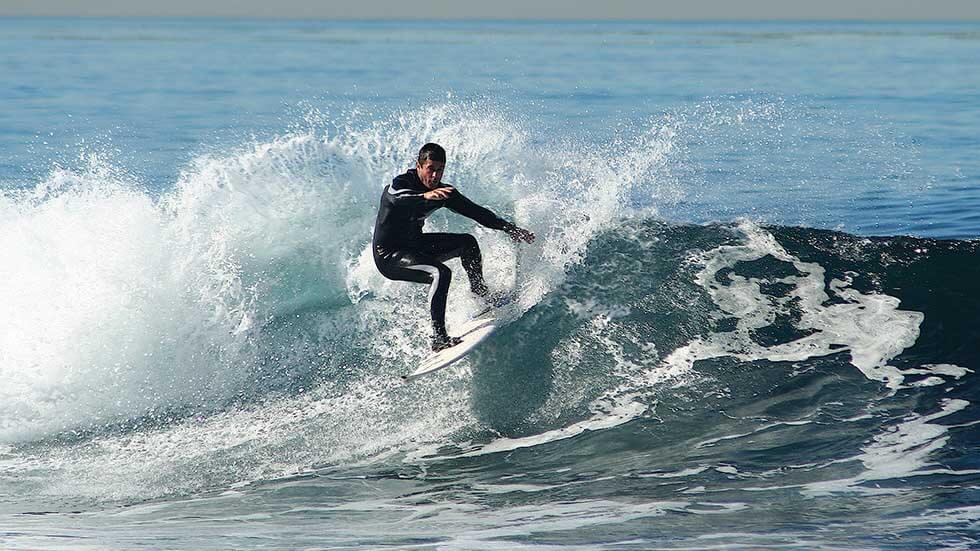
San Diego, California, is synonymous with surfing, which is year-round recreation at a handful of superlative surf-ready beaches. Courtesy of sandiego.org
CATCHING A WAVE IN SAN DIEGO, CALIFORNIA
Surfing is more than a sport in America’s Finest City; it’s a way of life. That’s largely thanks to the city’s near-perfect climate (who doesn’t like sunny days averaging in the 70s?) and 17 miles of surf-ready coastline with lifeguard-patrolled public beaches just a pebble’s throw from downtown.
Surfing is year-round recreation here, and a variety of beaches are suited to surfers of varied skill levels. Among the city’s nine beaches with permanent lifeguard stations (dozens more host lifeguard stations during the summer), North Pacific Beach’s Tourmaline Surfing Park is a favored spot for beginning surfers attracted to its low wave swells. Neighboring Mission Beach also appeals to novices with its easy rollers—plus, a surfside boardwalk and amusement park.
Families with children learning to hang ten are drawn to La Jolla Shores in the tony La Jolla neighborhood, known for having the gentlest waves in San Diego. Serious shredders will want to head to Black’s Beach, with a powerful rideable surf in the 10- to 12-foot range. For the most consistently surfable break, Windansea Beach is popular for its hard surf breaks created by underwater reefs and its dramatic scenery framed by rocky shoreline.
Not surprisingly, this surf-centric city has a slew of surf schools for lessons, camps, and retreats. Typical skills covered include water safety, board handling, balance training, and paddling techniques. You’ll also find equipment rental centers hawking boards and wetsuits and surf-inspired apparel shops dotting the coastline and downtown. A 40-minute drive from the city, you can delve into surf culture and history at the California Surf Museum in Oceanside, with exhibits chronicling the history of surfboards and wave riding, including, of course, in “Sun” Diego.
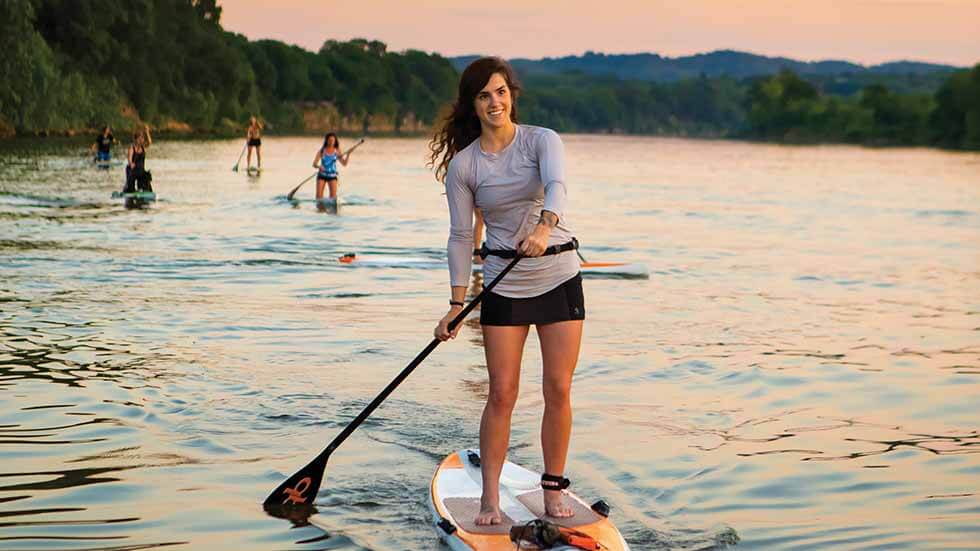
Stand-up paddle boarding is among the most popular pastimes on Nashville, Tennessee’s surrounding waterways. Courtesy of paddle up Nashville.
PADDLING OUT IN NASHVILLE, TENNESSEE
Sure, the Volunteer State’s capital city is famous for its music legacy, with the Grand Ole Opry, Ryman Auditorium, Country Music Hall of Fame and Museum, and a bevy of honky-tonks. But Music City is no single-dimension destination. Nashville also knows how to have fun in its great outdoors, graced with numerous lush parks and a 180-mile-long greenway. The stars of the outdoor show, however, may be the city’s surrounding waterways.
From spring through fall, recreation abounds on the three lakes near the center of the city—J. Percy Priest Lake, Old Hickory Lake, and Radnor Lake—and the mighty Cumberland River, which churns right through downtown, eventually flowing into J. Percy Priest and Old Hickory. In 2012, Nashville even earned a spot on Outside magazine’s top-10 list of The Best River Towns in America.
Among the more popular ways to get out on the water is on a standup paddleboard (SUP). Located at the Rock Harbor Marina on the Cumberland River, Paddle Up Nashville provides everything from boards and paddling equipment to classes and lessons for a day of navigating the river. (You can even SUP with your dog on a “woof board.”) Once on the water, be on the lookout for blue herons, snowy egrets, bald eagles, beavers, turtles, a variety of fish, and other local wildlife.
If kayaking is more your speed, check out River Queen Voyages, a mobile outfitter (with no brick-and-mortar location) offering guided and self-guided kayak tours, including an active-paddle Skyline cruise on the Cumberland River that serves up postcard-perfect views of the city.
To experience Nashville’s lake life, head to Nashville Paddle Company, with a boathouse inside the Hamilton Creek Recreation Area on J. Percy Priest Lake. Along with board and equipment rentals, Nashville Paddle offers lessons, paddleboard fitness classes, sunset social paddles, and full-moon paddles that showcase Music City’s literal stars.
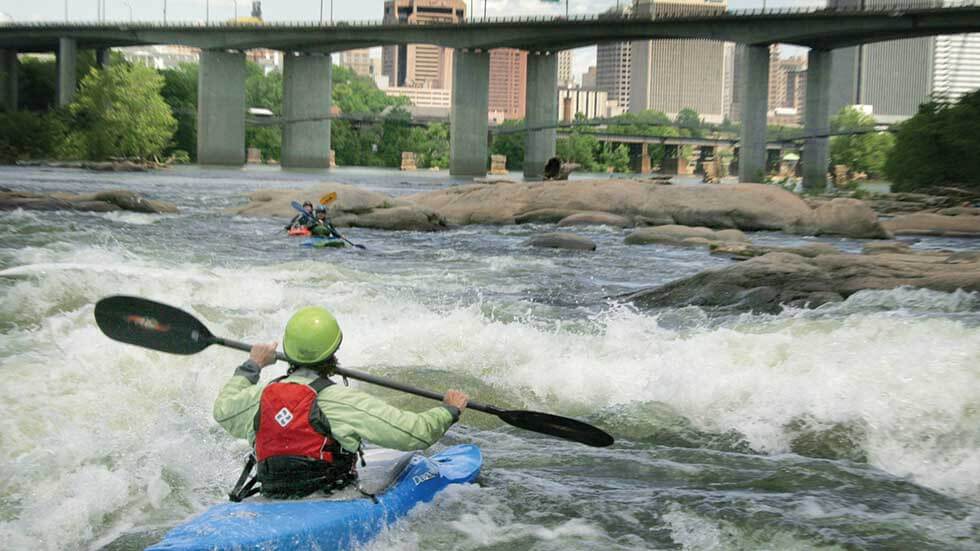
The James River, which runs through downtown Richmond, Virginia, dispenses Class I through IV rapids ideal for whitewater recreational pursuits. Courtesy of Richmond Region Tourism
RUNNING THE RAPIDS IN RICHMOND, VIRGINIA
Whitewater kayaking and rafting in the heart of a city is not only a thing; it’s a big thing in this bustling capital. Here, the James River, which begins in the Appalachian Mountains and ends in the Chesapeake Bay, boasts falls that drop 105 feet over seven miles, dispensing Class I through IV rapids and constituting the only whitewater that flows through the heart of an urban area, according to the nonprofit James River Association (JRA).
Several city launch and takeout sites make it easy to shoot the rapids via kayak, raft, or even paddleboard (yes, whitewater SUP is available). Local companies such as RVA Paddlesports and Riverside Outfitters can equip you with helmets, personal floatation devices, paddles, kayaks, and rafts. They also offer safety programs and skills classes as well as guided family-friendly adventures and long runs on big rapids. Beginners can set out on flatwater sections of the river to learn the essentials and delve into the nature of the river before progressing to Class I and II rapids on the Upper James. More experienced kayakers and rafters can tackle Class III and IV rapids on the Lower James, with the Richmond skyline providing a photogenic backdrop.
While on the river, you’ll pass under iconic bridges and by small islands, including the 54-acre city park Belle Isle, where you can pause for a picnic. The James River is also the largest roosting area on the Eastern Seaboard for bald eagles, according to the JRA, so keep watch for eagles as well as sightings of ospreys and blue herons.
Flanking both sides of the river, the 550-acre James River Park System offers opportunities for hiking, biking, and recreational tree climbing as well. Of course, it’s running the rapids that’s de rigueur for locals and visitors alike. As the folks at Richmond Region Tourism point out, Richmond is the only city in the U.S. where you can shoot the rapids, pull out of the river, and then walk to a downtown restaurant or brewery, experiencing the best of both urban and natural worlds.
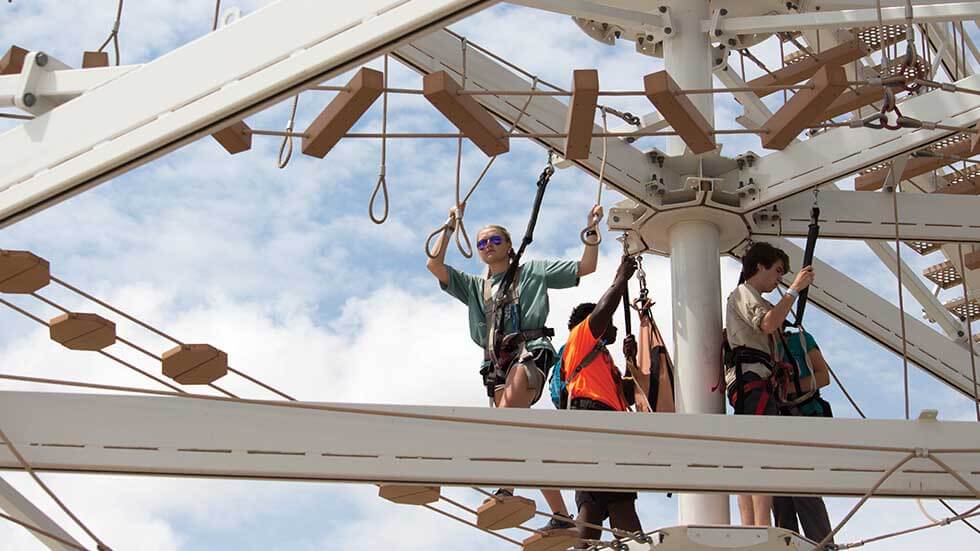
District to cap off the day at a trendy restaurant or bar, art gallery, museum or even a professional ballpark for more passive, spectator-oriented pursuits. Photos courtesy of Vsitokc.com
IF YOU BUILD IT IN OKC
Oklahoma may be landlocked and predominantly flat, but that doesn’t stop the Sooner State’s capital city from supplying world-class whitewater thrills. When you lack a natural resource such as urban whitewater rapids, in Oklahoma City (OKC), you simply build them.
That’s where RIVERSPORT Rapids comes in. Opened in 2016 in the Boathouse District along the
Oklahoma River, this $45 million whitewater rafting and kayaking center delivers Class II through IV rapids, which can be adjusted to your adventure-level liking. Lower flow channels cater to guided family-friendly rafting and kayaking, while higher flows provide Olympic athletes with challenging conditions for training. (The Boathouse District is the US Olympic and Paralympic Training Site for canoe/kayak and rowing.) You can also ride the rapids on an inner tube.
But those aren’t the only recreational pursuits to love here. Climbers will want to ascend RIVERSPORT’s SandRidge Sky Trail, an 80-foot-tall adventure course—the world’s tallest such course—with four Sky Slides, a six-story free fall and a 700-foot zip line across the Oklahoma River. Surfers can catch waves at Surf OKC for a flowboarding experience, and skiers and snowboarders will soon be able to practice their slalom skills and jumps on an infinite, articulating indoor slope at Ski OKC, slated to open this spring.
Oklahoma City’s Boathouse District also offers flatwater kayaking, canoeing, stand-up paddleboarding, rowing, and more on the Oklahoma River and has 13 miles of paved trails for running, walking, and cycling as well as trails for mountain biking. If all that doesn’t tire you out, you can take a walk from the Boathouse District to the city’s Bricktown Entertainment District to cap off the day at a trendy restaurant or bar, art gallery, museum, or even a professional ballpark for more passive, spectator-oriented pursuits.
